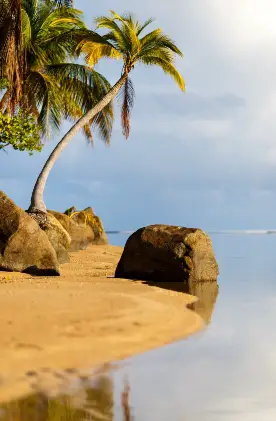Standing at 15,777 feet (or 4,810 meters) Mont Blanc is the tallest mountain peak in Western Europe. Despite its prominence and fame, I only recently found out about it so it hasn’t actually been on my bucket list for a while.
There is a famous resort at the base of Mont Blanc called Chamonix. I did hear of this town but never associated it with the mountain. I knew about it as a ski town – one of the more popular and touristy ones in France. What inspired me to climb Mont Blanc was the fact that it’s the tallest peak in Western Europe. It’s the tallest mountain I have climbed to date!
My friend Simon, who I met on Mount Whitney in December 2021, joined me on this climb. Simon is a German alpinist who has climbed Blanc before so I knew I could use his expertise on the mountain to help guide the trek. I flew into Switzerland and Simon drove from Germany to pick me up.
We drove to Aosta, Italy to do a warm up hike, followed by Mont Blanc in France a few days later. In total the trip was one and a half weeks long. We stayed in Italy for three days to climb Monte Emilius leading up to Blanc. Afterwards, we drove to France and stayed in Chamonix for four days.
The Mont Blanc massif straddles the border of France and Italy, so the distance we spent driving between the two countries wasn’t too much and the summit is shared between both countries. After climbing Blanc, I took a bus to Paris where I spent my last three days before flying back home.


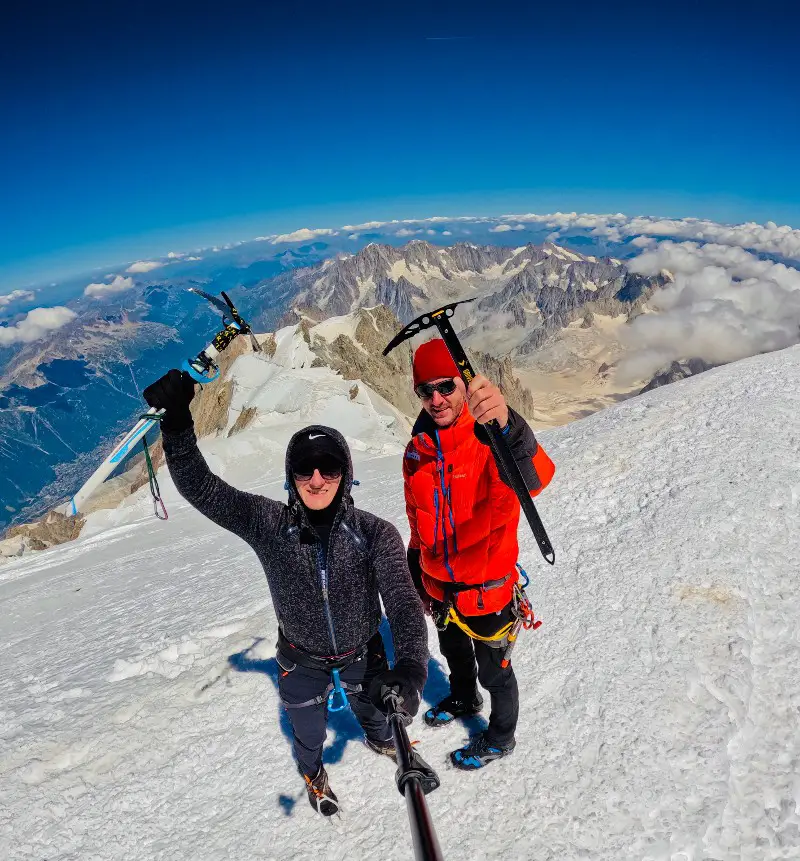
Preparing for the Climb of a Lifetime
I had spent most of my summer doing strenuous hikes. Recently in the United Stated I had climbed Mount Shasta two weeks earlier leading up to Mont Blanc, which is a 14er in the State of California. It was a difficult climb but not quite as difficult as Mont Blanc. It was good training leading up to Mount Blanc because the altitude of Mount Shasta at 14,179 feet was comparable to that of Mont Blanc (only 1,600 feet shorter than Blanc).
Blanc is similar to Rainier in terms of glacier travel so mountaineering experience and crevasse rescue skills are required. The most dangerous section is the Grand Couloir at 11,000 feet due to the dangers of rockfalls caused by warm weather. We crossed this section at night (2am) when things were frozen to minimize the chances of encountering rock falls.


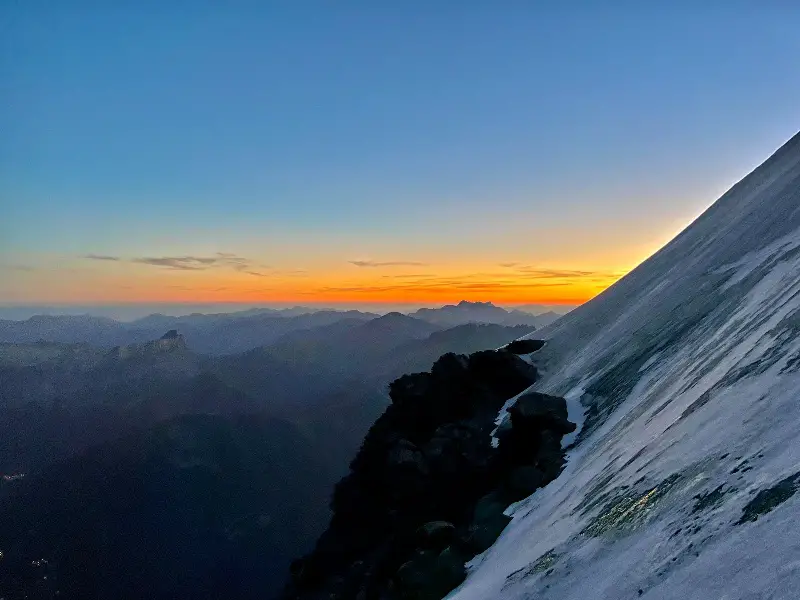
Two Days Trekking up Mount Blanc
The climb up Mont Blanc typically takes three or four days under normal conditions. It took Simon and I 40 hours to complete (just under two days). On the first night we stayed at Tete Rousse Hut and on the second we spent some time in Gouter Hut before the climb down. These huts require prior reservations and usually cost between $30 – $80 per person. You can stay in them without a reservation only under emergency situations.
The alps in Europe have a cool mountain-hut culture. The accommodations in these huts are convenient (you sleep in bunk beds and meals are provided at an additional charge). We reached the summit at 2pm on day two and spent around an hour up there before starting our descent. The hike can be split into five sections. Thinking about it in these terms helped me tackle the trek one section at a time and ensured a successful summit:
- Chamonix (3,700 feet) to Train Station (8,000 feet)
- Train Station (8,000 feet) to Tete Rousse Hut (10,000 feet)
- Tete Rousse Hut (10,000 feet) to Gouter Hut (12,500 feet)
- Gouter Hut (12,500 feet) to Vallot Hut (14,300 feet)
- Vallot Hut (14,300 feet) to Summit (15,777 feet)
*Feet mentioned are approximates. The total change in elevation on the Mont Blanc climb was 12,000 feet. The most dangerous section of the trek (the Grand Couloir) is situated between Tete Rousse Hut and Gouter Hut.



Conditions on the Mont Blanc Summit Hike
Mountains create their own weather pattern which makes it hard to predict what the weather will be like when you go up higher altitudes. We got lucky and caught a great two or three day window during our stay in Chamonix which afforded us the opportunity to make the summit push.
We had clear skies at the summit with some clouds in the distance and there was little to no wind at the top. On the way back down to Gouter Hut some clouds rolled in and made visibility difficult on our descent, but we knew the correct direction to head in so it wasn’t too much of a nuisance.
Prime climbing season for Mont Blanc runs through the summer months, with conditions deteriorating after August. Conditions are unstable in the winter and spring due to avalanche danger caused by changing weather. It’s important to note that due to record high temperatures in the alps this summer, guided treks are no longer being offered for the rest of the year.
I should also say that a guide is not required but it’s a good idea to go with someone who is familiar with the mountain because the route is always changing due to glaciers opening up in higher altitudes. The police on Mont Blanc don’t allow for solo hikers going beyond Tete Rousse Hut as you must be on a rope team of at least two on the glacier above Gouter Hut.

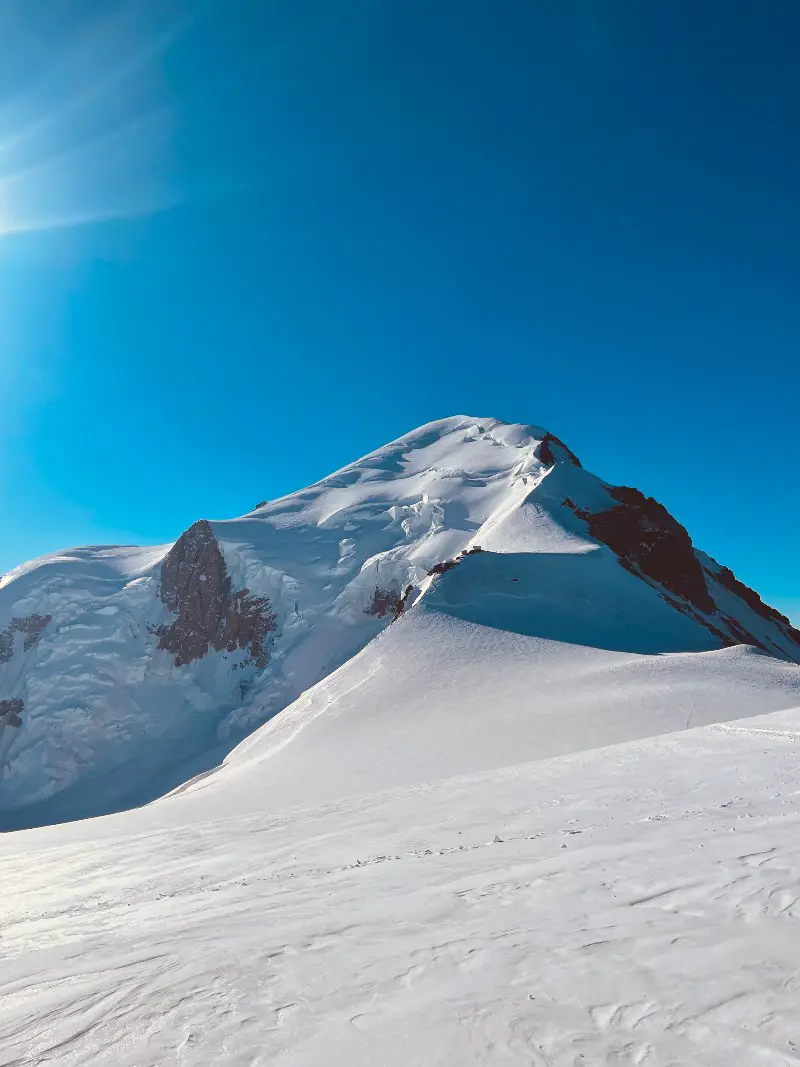
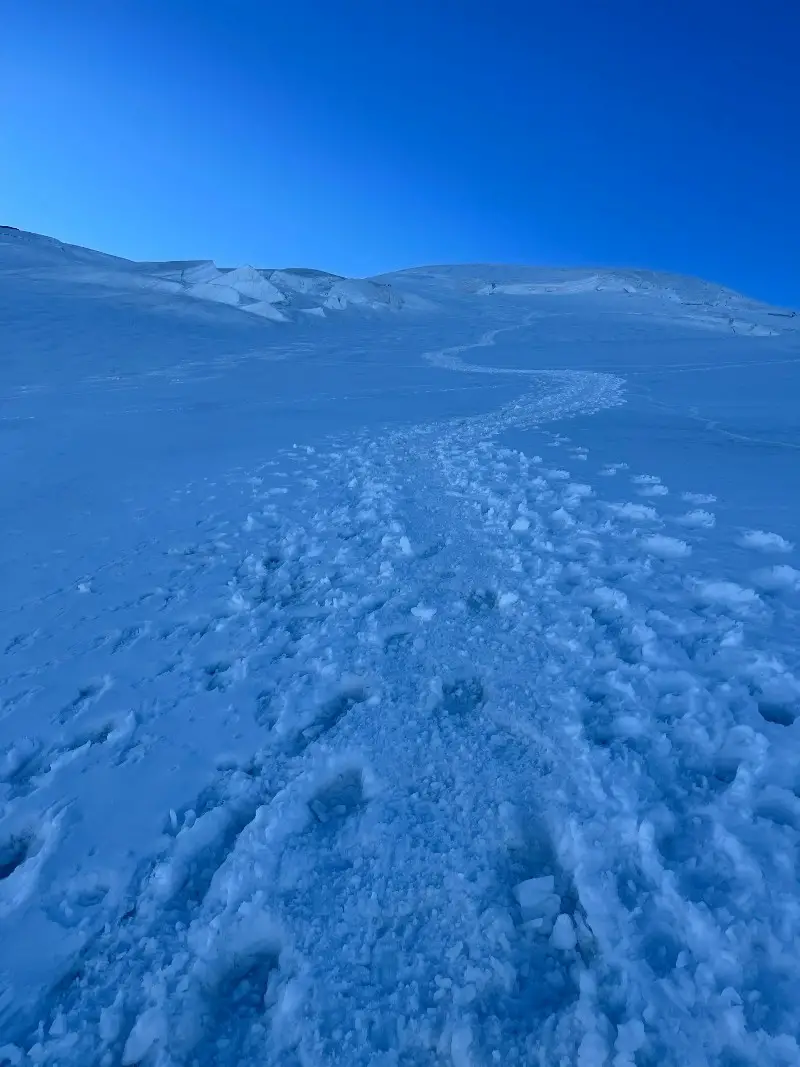
Challenges & Rewards of the Mountain
The trek up Mont Blanc rises from the valley in Chamonix to a breathtaking, glaciated mountain top. There is no well-defined trail up Blanc from bottom to top. The terrain is stunning the entire way and changes drastically as you gain altitude. The most beautiful part was the sunset we experienced from Tete Rousse Hut and the epic view from the summit.
The most challenging section of Mont Blanc in terms of navigation was just beyond Tete Rousse Hut at the Grand Couloir. This section is difficult to navigate due to the rock falls which can result in serious injury or even death. It’s the section of the trek where most mountain accidents occur. The route up the Grand Couloir is a Class 3 scramble up loose rock, so you need to know what you are doing and watch where you step.



Highlight for Me: Summiting the Peak
The most incredible feeling from this climb was standing at the summit. You can see down the valley to Chamonix – it feels like you are on top of the world! You must experience it to believe it. It’s important to note that the mountain is crumbling due to climate change and so I’m not sure how much longer the route up the summit will last. It’s possible that the route will become more technical in future years as the glaciers continue to melt.





Tips for Climbing Mont Blanc
- No permit is required to hike Mont Blanc
- Know how to use your equipment properly
- Take crevasse rescue and self-arresting courses
- Ensure you have the proper gear for mountaineering
- Make reservations at the huts in advance to avoid no vacancy situations
- Keep an eye on the weather and know when to turn around if the conditions worsen.
- Cross the Grand Couloir between the hours of 2am to 5am to minimize the chances of rockfall.
- Give yourself enough time to head back down in daylight to avoid dangerous situations.
- I recommend doing vigorous cardio a couple months leading up to your trek so you are in the best condition possible.
- You are not allowed to go solo and will be turned around by the mountain police if you try, so make sure you have a climbing partner.
- A guided trek on this mountain costs $2,000 to $3000. A guide is not required but I recommend taking one for the best experience possible.













